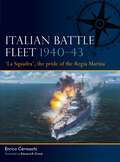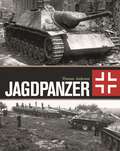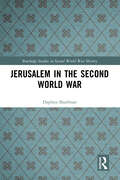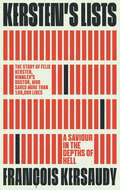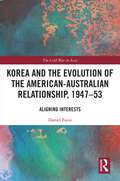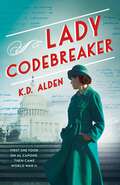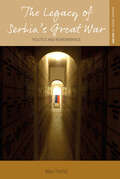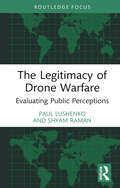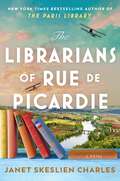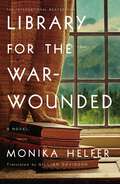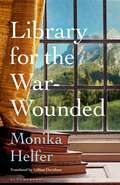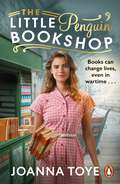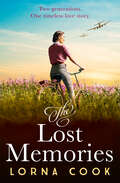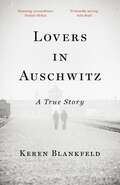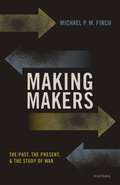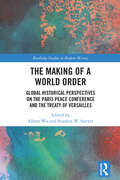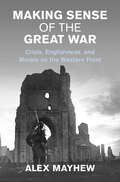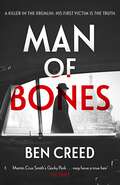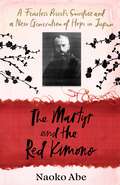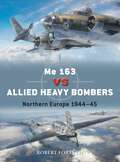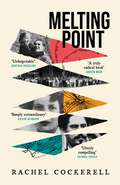- Table View
- List View
Italian Battle Fleet 1940–43: 'La Squadra', the pride of the Regia Marina (Fleet #6)
by Enrico CernuschiA comprehensive. illustrated account of the wartime Italian battle fleet, from its ships and technology to command structure, logistics, codebreaking and more.In the 1920s, the Italian Navy faced great challenges. Mussolini's ambitious Italy turned away from its alliance with Britain and France, and the Regia Marina faced the prospect of confronting both the French Navy and the Mediterranean Fleet of the Royal Navy. In the years leading up to World War II, the Regia Marina built and deployed a powerful battleship-led fleet – known in Italy as 'La Squadra' – intended to make the Mediterranean an Italian sea once more. In this book, Italian naval historian Enrico Cernuschi offers a fresh assessment of the wartime Italian battle fleet, based on his lifetime of primary-source research from both Italian and Allied sources. It offers a comprehensive portrait of this proud armada, how it was devised and built, and how it operated and fought. It covers a multitude of factors often overlooked, such as Italy's naval codebreakers, the fleet's logistics, and the qualities and limitations of Italian industry that supported it. The book also provides a concise account and analysis of the battle fleet's activities through the war, from major clashes such as the Battle of Calabria to lesser-known expeditions. The author's research into Italian wartime primary sources overturns some myths still commonplace in Anglo-American accounts. Illustrated with superb new artwork, maps and 3D diagrams, and featuring rare photos, this book is a fascinating account of Italy's great fleet of World War II.
Jagdpanzer
by Thomas AndersonThis highly illustrated title details the history of the Jagdpanzer, the self-propelled German tank destroyers introduced in the second half of World War II. Throughout World War II all sides grappled with how to deal with the threat of enemy armour. The German Army had adopted the 3.7cm anti-tank gun in the inter-war years. However, it was already apparent that the towed weapons lacked firepower and more powerful weapons were introduced in 1942 and 1943.By 1942, hard-pressed Panzerjäger (anti-tank) units equipped with towed anti-tank weapons fighting on the Eastern Front increasingly sought assistance from StuG-equipped assault artillery units. By late 1943 the StuG was being issued to new tank destroyer units and at the same time a dedicated Jagdpanzer (hunting tank) was ordered, based on the chassis and running gear of the PzKpfw IV.This highly illustrated study by German armour expert Thomas Anderson uses archival material and after-action reports to describe the development of the Jagdpanzer, and the many variants built on other German tank chassis. It also covers in detail how Jagdpanzer units were organized as well as their operational experience on the battlefield.
Jerusalem in the Second World War (Routledge Studies in Second World War History)
by Daphna SharfmanThis book is the first to present the unique story of the city of Jerusalem during the events of the Second World War and how it played a unique role in both the military and civilian aspects of the war. Whilst Jerusalem is usually known for topics such as religion, archaeology, or the politics of the Israeli–Arab conflict, this volume provides an in-depth analysis of this exceptional and temporary situation in Jerusalem, offering a perspective that is different from the usual political-strategic-military analysis. Although battles were raging in the nearby countries of Syria and Lebanon, and the war in Egypt and the Western Desert, the people who came to Jerusalem, as well as those who lived there, had different agendas and perspectives. Some were spies and intelligence officers, other were exiles or refugee immigrants from Europe who managed at the last moment to escape Nazi persecution. Journalists and writers described life in the city at this time. All were probably conscious of the fact that when the war came to an end, local rivalry and mounting conflict would take the centre stage again. This was a time of a special, magical drawn-out moment that may shed light on an alternative, more peaceful, kind of Jerusalem that unfortunately was not to be. This volume seeks to find an alternative approach and to contribute to the development of insightful research into life in an unordinary city in an unordinary situation. It will be of value to those interested in military history and the history of the Middle East.
Jerusalem in the Second World War (Routledge Studies in Second World War History)
by Daphna SharfmanThis book is the first to present the unique story of the city of Jerusalem during the events of the Second World War and how it played a unique role in both the military and civilian aspects of the war. Whilst Jerusalem is usually known for topics such as religion, archaeology, or the politics of the Israeli–Arab conflict, this volume provides an in-depth analysis of this exceptional and temporary situation in Jerusalem, offering a perspective that is different from the usual political-strategic-military analysis. Although battles were raging in the nearby countries of Syria and Lebanon, and the war in Egypt and the Western Desert, the people who came to Jerusalem, as well as those who lived there, had different agendas and perspectives. Some were spies and intelligence officers, other were exiles or refugee immigrants from Europe who managed at the last moment to escape Nazi persecution. Journalists and writers described life in the city at this time. All were probably conscious of the fact that when the war came to an end, local rivalry and mounting conflict would take the centre stage again. This was a time of a special, magical drawn-out moment that may shed light on an alternative, more peaceful, kind of Jerusalem that unfortunately was not to be. This volume seeks to find an alternative approach and to contribute to the development of insightful research into life in an unordinary city in an unordinary situation. It will be of value to those interested in military history and the history of the Middle East.
Kersten's Lists: A Saviour in the Depths of Hell
by François KersaudyOskar Schindler is well known for having saved a thousand Jews from Nazi extermination during World War II. Yet Felix Kersten, Heinrich Himmler's personal physician, remains almost unknown to this day. Only Kersten was able to relieve the Reichsführer of his crippling and chronic abdominal pains. Though despising the Nazis, he continued to work for Himmler throughout the war, using his position to pass intelligence to Finland, Sweden and the Netherlands, and demanding as payment from Himmler the liberation of victims sentenced to imprisonment or death. Drawing on unseen archive material from Germany, Sweden, The Netherlands and Israel, François Kersaudy guides us in the footsteps of a man who exploited the politics of hatred and fear within the Third Reich to save the lives of over a hundred thousand people, including sixty thousand Jews.
Korea and the Evolution of the American-Australian Relationship, 1947–53: Aligning Interests (The Cold War in Asia)
by Daniel FazioFazio examines the significance of the US-Australian Korean engagement, 1947–53, in the evolution of the relationship between the two nations in the formative years of the Cold War. In the aftermath of World War Two, divergent American and Australian strategic and security interests converged and then aligned on the Korean peninsula. Fazio argues that the interactions between key US and Australian officials throughout their Korean engagement were crucial to shaping the nature of the evolving relationship and the making of the alliance between the two nations. The diplomacy of Percy Spender, John Foster Dulles, and James Plimsoll was particularly crucial. He demonstrates that the American evaluation of the geo-strategic significance of Korea was a significant factor in the making of the ANZUS alliance and events in Korea remained central to the evolving US-Australian relationship. Their Korean engagement showed the US and Australia had similar and overlapping, rather than identical interests, and that their relationship was much more nuanced and problematic than commonly perceived. Fazio challenges the Australian mythology on the origins of the ANZUS Treaty and presents a cautionary insight into the limits of Australia’s capacity to influence US policy to benefit its interests. An insightful read for diplomatic historians, providing greater depth to understanding the broader historical context of the trajectory of the US-Australian relationship and alliance since the beginning of the Cold War.
Korea and the Evolution of the American-Australian Relationship, 1947–53: Aligning Interests (The Cold War in Asia)
by Daniel FazioFazio examines the significance of the US-Australian Korean engagement, 1947–53, in the evolution of the relationship between the two nations in the formative years of the Cold War. In the aftermath of World War Two, divergent American and Australian strategic and security interests converged and then aligned on the Korean peninsula. Fazio argues that the interactions between key US and Australian officials throughout their Korean engagement were crucial to shaping the nature of the evolving relationship and the making of the alliance between the two nations. The diplomacy of Percy Spender, John Foster Dulles, and James Plimsoll was particularly crucial. He demonstrates that the American evaluation of the geo-strategic significance of Korea was a significant factor in the making of the ANZUS alliance and events in Korea remained central to the evolving US-Australian relationship. Their Korean engagement showed the US and Australia had similar and overlapping, rather than identical interests, and that their relationship was much more nuanced and problematic than commonly perceived. Fazio challenges the Australian mythology on the origins of the ANZUS Treaty and presents a cautionary insight into the limits of Australia’s capacity to influence US policy to benefit its interests. An insightful read for diplomatic historians, providing greater depth to understanding the broader historical context of the trajectory of the US-Australian relationship and alliance since the beginning of the Cold War.
Lady Codebreaker
by K.D. AldenFans of Kate Quinn and Kristina McMorris will love this gripping historical novel based on the true story of the woman who used her codebreaking skills to bring down Prohibition gangsters and WWII Nazis, and who ultimately helped found the present-day CIA. Grace Smith has never been one to conform to society&’s expectations. She flees small-town Indiana to seek adventure—and finds more than she bargained for when she&’s hired by an eccentric millionaire to learn codebreaking. Soon she&’s using those skills to help head the government&’s fledgling cryptanalysis unit. During Prohibition, Grace takes up the fight against rumrunners—not to mention Al Capone himself. And as the country careens from one Great War to another, it&’s Grace who must crack the secrets of foreign governments, catch spies, and derail saboteurs . . . before it&’s too late. With wry wit and sheer grit, she forges her own path as a codebreaker, wife, mother. She&’s spent a lifetime going up against powerful men and winning. But as war rages and the stakes grow impossibly high, Grace faces a truly impossible choice: her family or her country?
The Legacy of Serbia's Great War: Politics and Remembrance (Making Sense of History #48)
by Alex TomićIn the winter of 1915, following the invasion of Serbia by the Central Powers, the Serbian Army retreated across the mountains of Albania and Montenegro together with thousands of civilians. Around 240,000 lost their lives. Today, the story of the retreat is little known, except in Serbia where it is represents the heroic Serbian sacrifice in the Great War. In this book Alex Tomić examines the centenary events memorializing the First World War with the retreat at its core, and provides a persuasive account of the ways in which the remembrance of Serbian history has been manipulated for political purposes. Whether through commemorations, ceremonies, or grass- root initiatives, she demonstrates how these have been used as distractions from the more recent unexamined past and in doing so provides an important new perspective on the cultural history of commemoration.
The Legitimacy of Drone Warfare: Evaluating Public Perceptions
by Paul Lushenko Shyam RamanThis book examines public perceptions of the legitimacy of drones, and how this affects countries’ policies on and the global governance of drone warfare.Scholars recognize that legitimacy is central to countries’ use of drones, and political officials often characterize strikes as legitimate to sustain their use abroad. This book introduces and tests an original middle-range theory that allows scholars, policy-makers, and practitioners to understand how evolving patterns of drone warfare globally shape the public’s perceptions of legitimacy that can moderate countries’ drone policies and the global governance of drones. Rather than relate drone warfare to a platform or counterterrorism strikes only, as experts often do, this book argues that drone warfare is best understood as a function of the unique ways that countries use and constrain strikes. By updating theories of drone warfare, this book provides a generalizable way to understand public perceptions of legitimacy in cross-national contexts, especially among democratic political regimes that are prefigured on political officials’ accountability for the use of force abroad.This book will be of interest to students of security studies, foreign policy, media and communication studies, and International Relations.
The Legitimacy of Drone Warfare: Evaluating Public Perceptions
by Paul Lushenko Shyam RamanThis book examines public perceptions of the legitimacy of drones, and how this affects countries’ policies on and the global governance of drone warfare.Scholars recognize that legitimacy is central to countries’ use of drones, and political officials often characterize strikes as legitimate to sustain their use abroad. This book introduces and tests an original middle-range theory that allows scholars, policy-makers, and practitioners to understand how evolving patterns of drone warfare globally shape the public’s perceptions of legitimacy that can moderate countries’ drone policies and the global governance of drones. Rather than relate drone warfare to a platform or counterterrorism strikes only, as experts often do, this book argues that drone warfare is best understood as a function of the unique ways that countries use and constrain strikes. By updating theories of drone warfare, this book provides a generalizable way to understand public perceptions of legitimacy in cross-national contexts, especially among democratic political regimes that are prefigured on political officials’ accountability for the use of force abroad.This book will be of interest to students of security studies, foreign policy, media and communication studies, and International Relations.
The Librarians of Rue de Picardie: From the bestselling author, a powerful, moving wartime page-turner based on real events
by Janet Skeslien CharlesThe New York Times bestselling author of the The Paris Library returns with a powerful, moving new novel based on the extraordinary true story of Jessie Carson, the American librarian determined to bring books to the children of war-torn France.'This is hands down my book of 2024. A rich, glorious life-affirming ode to the power of books and female solidarity. Simply unforgettable!' KATE THOMPSON'A wonderful story about the power books have not only to inspire, but also to rescue and restore. The characters are so richly drawn... I absolutely loved it' RUTH HOGAN------------------------Under what was left of the roof of the ruined cottage, a girl with pigtails perched on a pile of rubble, hunched over a book...1918: As the Great War rages, Jessie Carson takes a leave of absence from the New York Public Library to work for the American Committee for Devastated France, a group of women determined to rebuild devastated French communities just miles from the front. Upon arrival, Jessie strives to establish something that the French have never seen - children's libraries. She turns ambulances into bookmobiles and trains the first French female librarians. Then she disappears.1987: When NYPL librarian and aspiring writer Wendy Peterson stumbles across a passing reference to Jessie Carson in the archives, she becomes consumed with learning her fate. In her obsession, she discovers that she and the elusive librarian have more in common than their work at New York's famed library, but she has no idea their paths will converge in surprising ways across time.*Published under the title Miss Morgan's Book Brigade in the US*'An astonishing novel with the beating heart of courageous women who change the world through books. For every reader who was once told to get their head out of the clouds because they read too many books, this one is for you... A moving novel of sacrifice, heroism, and inspired storytelling immersed in the power of books to change our lives' PATTI CALLAHAN HENRY'Bursting with remarkable characters and filled with heart-in-mouth moments... an enthralling, emotional story rich in historical detail. Janet Skeslien Charles has done real justice to the legacy of these courageous women; this wonderful book is a gift to the reader' LIESE O'HALLORAN SCHWARZ'Bibliophiles are in for a treat' PUBLISHERS WEEKLY'I found myself captivated by this eye-opening book and reminder of the good that comes from dedicated hard work. I am grateful to Janet Skeslien Charles for educating me about the remarkable women of CARD' ⭐ ⭐ ⭐ ⭐ ⭐ Goodreads reviewer 'I love books about libraries and books. The fact that this book is actually based off of real people is amazing. This book celebrates the contributions that these women made when they are usually swept under the rug. I loved Jessie so much, and I will be thinking of these brave women for a long time to come' ⭐ ⭐ ⭐ ⭐ ⭐ Goodreads reviewer
Library for the War-Wounded
by Monika HelferThe internationally bestselling novel-a daughter's portrait of her WWII veteran father, assembled from shards of memory.We called him Vati, Dad. Not Papa. He thought it sounded modern. He wanted to present himself to us, and through us, as a man in tune with the modern age. A man who could be read as having a different past.Inspired by the author's family history, Library for the War-Wounded transports readers to the aftermath of World War II, uncovering the life of Helfer's father, Josef. Born with the stigma of illegitimacy, he found solace in books, and his education was eventually funded by the Catholic Church. Drafted into the Wehrmacht, he witnessed the horrors of the Eastern Front and returned from the war an amputee. He married his nurse and brought his family to the high, idyllic slopes of the Austrian Alps, where he took a position as manager of a convalescent home for war-wounded.Josef was a man of many mysteries. To his daughter Monika, none was greater than his obsession with the home's unlikely and remarkable library, his great treasure and comfort as the country barrels away from the memory of war. He will stop at nothing to save it-even when it tears apart his family. Beautifully restrained and compressed, Library for the War-Wounded turns lived experience into great literature by confronting the universal question: Can we ever truly know our parents?
Library for the War-Wounded
by Monika HelferFrom Monika Helfer's award-winning, internationally bestselling wartime trilogy, based on her own family. Translated into English for the first time.'We called him Vati, Dad. Not Father, not Papa. That's what he wanted. He thought it sounded modern. He wanted to present himself to us, and through us, as a man in tune with the modern age. Though he seemed to come from nowhere.'Josef was an illegitimate child, a charity case from Salzburg, schooled by a benefactor. He was drafted to fight in the Second World War while still at school and sent to Russia, returning with only one leg. He married his nurse, and brought his family to the high, idyllic slopes of the Austrian Alps, where he took a position as manager of a home for injured soldiers, a strangely suspended, deeply isolated place with a remarkable library.He was a man of many mysteries. To his daughter, Monika, none was greater than his obsession with these cloistered, crumbling books, his great treasure and secret amidst a country barrelling away from the memory of war.Beautifully written, restrained, and memorable, Library for the War-Wounded turns a real life into great literature by confronting the universal question: Who are our parents, really?
The Little Penguin Bookshop: A heart-warming and uplifting world war two novel about community, friendship and books
by Joanna Toye'Endearing characters [...] wartime loves, laughter and heartbreak' Annie Murray'An uplifting wartime saga with family at its heart' Tracy Baines 'Meticulously researched and beautifully written' Helen Yendall_________________________Books can change lives, even in wartime. . .When World War II breaks out, Carrie Anderson sets up a bookstall at her local train station in the hope of providing a sense of escapism for travellers, troops and evacuees.Driven by an entrepreneurial spirit and armed with a colourful array of Penguin paperbacks, Carrie’s business soon booms. And when she gifts a book to a dashing officer, an act of kindness becomes the beginning of Carrie’s very own love story.But as war rages on, and Mike is posted abroad, Carrie’s world is turned upside-down.With the help of her station community, and the power of her paperbacks, can Carrie find the strength to battle through?
The Lost Memories
by Lorna CookReaders will be captivated by this story of love, sacrifice, and destiny, where the past and present collide to rewrite the future.
Lovers in Auschwitz: A True Story
by Keren Blankfeld'Haunting and powerfully resonant... this is a story not just of remarkable individuals, but also a tribute to the wider indomitability of the human spirit at the darkest moment in European history' - Sinclair McKay, bestselling author of Berlin and DresdenZippi Spitzer and David Wisnia’s story began when they first locked eyes across the work floor. It was the start of a romance that could have unfolded anywhere if it weren’t for one key difference: Zippi and David were prisoners in history’s most infamous death camp.David and Zippi defied the odds by surviving for years beneath the ash-choked skies of Auschwitz. Shielded by the protection of their fellow inmates, saved on occasion by their own ingenuity and twists of fate, their love affair reminded them that their old world still existed – a world of possibilities, of freedom and desire. As the war’s end drew near, little did they know just how far their lives would diverge, and how many years would pass before they would meet again.An unbelievable true story of romance, sacrifice, loss, and resilience, Lovers in Auschwitz chronicles the lives of two young people ensnared in the Nazis’ horrific creation, who discovered hope and humanity in history’s darkest hour.
Making Makers: The Past, the Present, and the Study of War
by Michael P. FinchMaking Makers presents a comprehensive history of a seminal work of scholarship which has exerted a persistent attraction for scholars of war and strategy: Makers of Modern Strategy. It reveals the processes by which scholars conceived and devised the book, considering both successful and failed attempts to make and remake the work across the twentieth century, and illuminating its impact and legacy. It explains how and why these influential volumes took their particular forms, unearths the broader intellectual processes that shaped them, and reflects on the academic parameters of the study of war in the twentieth century. In presenting a complete genesis of the Makers project in the context of intellectual trends and historical contingency, this book reflects on a more complex and nuanced appraisal of the development of scholarship on war. In so doing it also offers contributions to the intellectual biographies of key figures in the history of war in the twentieth century, such as Edward Mead Earle, Peter Paret, Gordon Craig, and Theodore Ropp. Making Makers contributes to an intellectual history of military history and contextualises the place of history and historians in strategic and security studies. It is not only a history of the book, but a history of the networks of scholars involved in its creation, their careers, and lines of patronage, crossing international boundaries, from Europe to the USA, to Asia and Australia. It is an investigation of ideas, individuals, and groups, of work completed and scholarship produced, as well as contingency and opportunities missed.
The Making of a World Order: Global Historical Perspectives on the Paris Peace Conference and the Treaty of Versailles (Routledge Studies in Modern History)
by Albert Wu Stephen W. SawyerWhy does 1919 deserve further study and debate a hundred years later? What lessons for global history may we learn from the world order created at the end of the Great War? Drawing insight from the global turn of the past several decades that has forced us to reconsider the most important world events and processes since the French Revolution and especially the growing interest in World War I as a global conflict that extended far beyond the borders of Europe, this volume explores the global political ramifications of the treaties prepared at the Paris Peace Conference in 1919 by focusing on key topics: how the Paris Peace Conference re-shaped the geo-political configurations of the Middle East, the importance of transformations in Asia and particularly China in the immediate postwar period, the shifts in Southeastern Europe, new feminist movements in Central Europe, and the pre-history of neoliberalism. Read together, the papers demonstrate how the peace treaties signed in 1919 and 1920 marked a profound transformation on local, national, continental, and global scales.
The Making of a World Order: Global Historical Perspectives on the Paris Peace Conference and the Treaty of Versailles (Routledge Studies in Modern History)
by Albert Wu Stephen W. SawyerWhy does 1919 deserve further study and debate a hundred years later? What lessons for global history may we learn from the world order created at the end of the Great War? Drawing insight from the global turn of the past several decades that has forced us to reconsider the most important world events and processes since the French Revolution and especially the growing interest in World War I as a global conflict that extended far beyond the borders of Europe, this volume explores the global political ramifications of the treaties prepared at the Paris Peace Conference in 1919 by focusing on key topics: how the Paris Peace Conference re-shaped the geo-political configurations of the Middle East, the importance of transformations in Asia and particularly China in the immediate postwar period, the shifts in Southeastern Europe, new feminist movements in Central Europe, and the pre-history of neoliberalism. Read together, the papers demonstrate how the peace treaties signed in 1919 and 1920 marked a profound transformation on local, national, continental, and global scales.
Making Sense of the Great War: Crisis, Englishness, and Morale on the Western Front (Studies in the Social and Cultural History of Modern Warfare)
by null Alex MayhewThe First World War was an unprecedented crisis, with communities and societies enduring the unimaginable hardships of a prolonged conflict on an industrial scale. In Belgium and France, the terrible capacity of modern weaponry destroyed the natural world and exposed previously held truths about military morale and tactics as falsehoods. Hundreds of thousands of soldiers suffered some of the worst conditions that combatants have ever faced. How did they survive? What did it mean to them? How did they perceive these events? Whilst the trenches of the Western Front have come to symbolise the futility and hopelessness of the Great War, Alex Mayhew shows that English infantrymen rarely interpreted their experiences in this way. They sought to survive, navigated the crises that confronted them, and crafted meaningful narratives about their service. Making Sense of the Great War reveals the mechanisms that allowed them to do so.
Man of Bones: From the author of The Times 'Thriller of the Year' (A\revol Rossel Thriller Ser.)
by Ben CreedTHE TIMES 'THRILLER OF THE YEAR' AND CWA GOLD DAGGER SHORTLISTED AUTHOR RETURNS!'Ben Creed has a genuine gift for conjuring up Stalin's Leningrad in all its beauty and misery' THE TIMES'You'll find yourself looking over your shoulder when you leave the house!' Trevor WoodWinter 1953. Beneath a pitch-black Leningrad sky, two bodies lie near the towering statue of Lenin outside the Finland Station. 'Nothing sinister, here, just a simple hit and run,' an officer in the MGB secret police assures militia detective Revol Rossel. Now he knows it's murder.Only recently released from a brutal Siberian labour camp and determined to find his missing sister at last, Rossel wants nothing to do with this new case. But his alcoholic, broken superior officer, Captain Lipukhin, seizes upon it as his salvation - a last chance to be a true Soviet hero.Along with sharp-witted Senior Lieutenant Lidia Gerashvili, and Major Nikitin, the interrogator who once cut off Rossel's fingers, Rossel sets off on the trail of a murderer whose crimes surpass those of even the deranged tsar Ivan the Terrible. A trail leading to a dark, hidden episode in Bolshevik history filled with unspeakable horrors.There is only one eyewitness - Vladimir Ilyich Ulyanov, better known as Lenin, whose giant right hand stretches out towards the frozen River Neva. Lenin, Rossel thinks, seems to be pointing at someone. But who?PRAISE FOR BEN CREED'Reminded me of Gorky Park, only I liked this tense, complex thriller even better'JAMES PATTERSON'Brilliantly orchestrated and totally engrossing' THE CRIME WRITERS' ASSOCIATION'A worthy successor to Cruz Smith's Arkady Renko' FINANCIAL TIMES'A fantastically tense atmosphere . . . A spine-tingling page-turner' SUN
The Martyr and the Red Kimono: A Fearless Priest’s Sacrifice and A New Generation of Hope in Japan
by Naoko AbeThe remarkable true story of Saint Maximilian Kolbe, and the two men in war-torn Japan whose lives he changed forever.On the 14th of August 1941, a Polish priest named Maximilian Maria Kolbe was murdered in Auschwitz.Kolbe's life had been remarkable. Fiercely intelligent and driven, he founded a movement of Catholicism and spent several years in Nagasaki, ministering to the 'hidden Christians' who had emerged after centuries of oppression. A Polish nationalist as well as a priest, he gave sanctuary to fleeing refugees and ran Poland's largest publishing operation, drawing the wrath of the Nazis. His death was no less remarkable: he volunteered to die, saving the life of a fellow prisoner.It was an act that profoundly transformed the lives of two Japanese men. Tomei Ozaki was just seventeen when the US dropped an atomic bomb on Nagasaki, destroying his home and his family. Masatoshi Asari worked on a farm in Hokkaido during the war and was haunted by the inhumane treatment of prisoners in a nearby camp. Forged in the crucible of an unforgiving war, both men drew inspiration from Kolbe's sacrifice, dedicating their lives to humanity and justice. Ozaki followed in his footsteps and became a friar. Asari created cherry trees as peace offerings.In The Martyr and the Red Kimono, award-winning author Naoko Abe weaves together a deeply moving and inspirational true story of resistance, sacrifice, guilt and atonement.
Me 163 vs Allied Heavy Bombers: Northern Europe 1944–45 (Duel #135)
by Robert ForsythAn illustrated account of the dramatic engagement between the Luftwaffe's Me 163 units and Allied bombers during the closing years of World War II.In the summer of 1944, US Army Air Force (USAAF) aircrews flying over the Third Reich reported observing small, high-speed 'batlike' aircraft flying close to their formations. The Luftwaffe's extraordinary Messerschmitt Me 163 rocket-powered interceptor was making its devastating debut with Jagdgeschwader (JG) 400. Capable of reaching high altitudes in the shortest possible time by using a volatile rocket fuel, the Me 163 was the Luftwaffe's most impressive yet dangerous aircraft, and the fastest in the world. Luftwaffe expert Robert Forsyth details the testing of the aircraft and its lethal SG 500 'Fighter Fist' weapons system, as well as its deployment against the B17s and B24s of the USAAF's Eighth Air Force and, from late 1944, the Lancasters and Halifaxes of RAF Bomber Command. These duels started a deadly form of warfare, with the bomber squadrons striking at Germany's synthetic oil refineries and jet airfields, and the Me 163s of JG 400 trying to stop them using cutting-edge aeronautical technology.Using specially commissioned artwork, original photographs and rare first-hand interviews with the pilots that fought the decisive dogfights, this exciting book describes the pivotal encounters over Northern Europe.
Melting Point: A groundbreaking family history for fans of Edmund de Waal and Philippe Sands
by Rachel Cockerell'A truly radical book; radical in subject, radical in form. For the most tragic reasons, it could not feel more immediate; and yet it's a fluid, fast-paced, hugely enjoyable and engaging read.' - Andrew Marr'Meticulously researched, elegantly constructed, unforgettable.' - Jonathan Freedland'This is an extraordinarily original way of writing memoir, history and truth. An enthralling book and a wonderful new writer.' - Laura CummingOn June 7th 1907, a ship packed with Russian Jews sets sail into the Atlantic. It is heading not to Jerusalem or New York, as many on board have dreamt, but to Texas. The man who persuades the passengers to go is David Jochelmann, Rachel Cockerell's great-grandfather. It marks the beginning of the Galveston Movement, a forgotten moment in history when 10,000 Jews fled to Texas in the lead-up to WWI.The charismatic leader of the movement is Jochelmann's closest friend, Israel Zangwill, whose beloved novels have made him a household name across Europe and America. As Russia becomes infected by anti-Semitic violence, and Theodor Herzl tries and fails to create a Jewish state, Zangwill embarks on a desperate search across the continents for a temporary homeland: from Australia to Canada, Angola to Antarctica. He reluctantly settles on Galveston, Texas. He fears the Jewish people will be absorbed into the great American melting pot, but there is no other hope. The story is told in a highly inventive format: there is no 21st-century narration. Instead the author weaves together a vivid and colourful account from an extraordinary array of sources - letters, diaries, memoirs, newspaper articles and interviews. Melting Point follows Zangwill and the Jochelmann family through two world wars, to London, New York and Jerusalem - as their lives intertwine with some of the most significant figures of the twentieth century, and each chooses whether to cling to their history, or brush it off like dust and melt into their new surroundings. It is a story that asks questions of belonging, identity, and what can be salvaged from the past.
